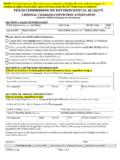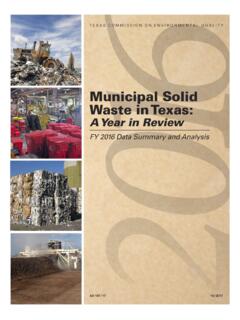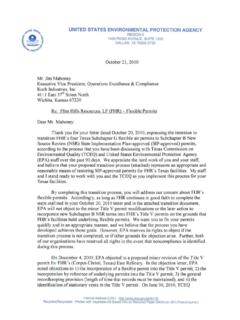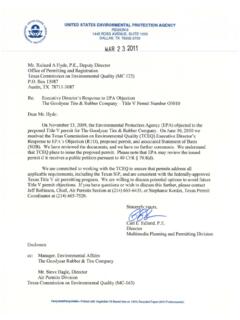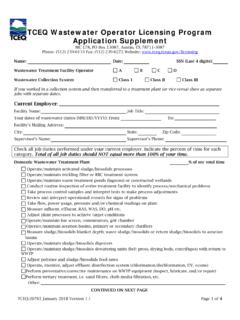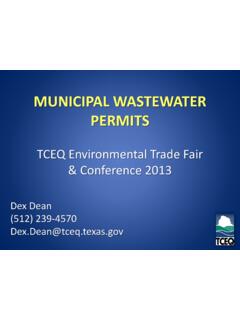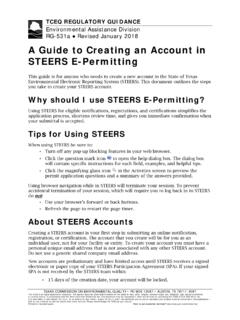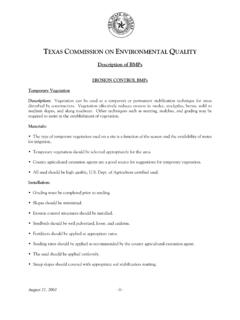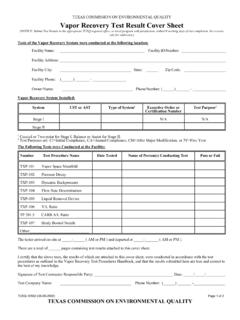Transcription of SUBCHAPTER E: BACKFLOW PREVENTION AND CROSS …
1 Texas Commission on Environmental Quality Page 1 Chapter 344 - Landscape Irrigation SUBCHAPTER E: BACKFLOW PREVENTION AND CROSS CONNECTIONS - Effective January 1, 2009 BACKFLOW PREVENTION Methods. (a) Any irrigation system that is connected to a public or private potable water supply must be connected through a commission-approved BACKFLOW PREVENTION method. The BACKFLOW PREVENTION device must be approved by the American Society of Sanitary Engineers; or the Foundation for CROSS -Connection Control and Hydraulic Research, University of Southern California; or the Uniform Plumbing Code; or any other laboratory that has equivalent capabilities for both the laboratory and field evaluation of BACKFLOW PREVENTION assemblies. The BACKFLOW PREVENTION device must be installed in accordance with the laboratory approval standards or if the approval does not include specific installation information, the manufacturer's current published recommendations.
2 (b) If conditions that present a health hazard exist, one of the following methods must be used to prevent BACKFLOW ; (1) An air gap may be used if: (A) there is an unobstructed physical separation; and (B) the distance from the lowest point of the water supply outlet to the flood rim of the fixture or assembly into which the outlet discharges is at least one inch or twice the diameter of the water supply outlet, whichever is greater. (2) Reduced pressure principle BACKFLOW PREVENTION assemblies may be used if: (A) the device is installed at a minimum of 12 inches above ground in a location that will ensure that the assembly will not be submerged; and (B) drainage is provided for any water that may be discharged through the assembly relief valve.
3 (3) Pressure vacuum breakers may be used if: (A) no back-pressure condition will occur; and (B) the device is installed at a minimum of 12 inches above any downstream piping and the highest downstream opening. Pop-up sprinklers are measured from the retracted position from the top of the sprinkler. (4) Atmospheric vacuum breakers may be used if: (A) no back-pressure will be present; Texas Commission on Environmental Quality Page 2 Chapter 344 - Landscape Irrigation (B) there are no shutoff valves downstream from the atmospheric vacuum breaker; (C) the device is installed at a minimum of six inches above any downstream piping and the highest downstream opening. Pop-up sprinklers are measured from the retracted position from the top of the sprinkler; (D) there is no continuous pressure on the supply side of the atmospheric vacuum breaker for more than 12 hours in any 24-hour period; and (E) a separate atmospheric vacuum breaker is installed on the discharge side of each irrigation control valve, between the valve and all the emission devices that the valve controls.
4 (c) BACKFLOW PREVENTION devices used in applications designated as health hazards must be tested upon installation and annually thereafter. (d) If there are no conditions that present a health hazard double check valve BACKFLOW PREVENTION assemblies may be used to prevent BACKFLOW if the device is tested upon installation and: (1) a local regulatory authority does not prohibit the use of a double check valve; (2) backpressure caused by an elevation of pressure in the discharge piping by pump or elevation of piping above the supply pressure which could cause a reversal of the normal flow of water or back-siphonage conditions caused by a reduced or negative pressure in the irrigation system exist; and (3) test cocks are used for testing only. (e) If a double check valve is installed below ground: (1) test cocks must be plugged, except when the double check valve is being tested; (2) test cock plugs must be threaded, water-tight, and made of non-ferrous material; (3) a y-type strainer is installed on the inlet side of the double check valve; (4) there must be a clearance between any fill material and the bottom of the double check valve to allow space for testing and repair; and (5) there must be space on the side of the double check valve to test and repair the double check valve.
5 Adopted June 4, 2008 Effective January 1, 2009 Specific Conditions and CROSS -Connection Control. Texas Commission on Environmental Quality Page 3 Chapter 344 - Landscape Irrigation (a) Before any chemical is added to an irrigation system connected to any potable water supply, the irrigation system must be connected through a reduced pressure principle BACKFLOW PREVENTION assembly or air gap. (b) Connection of more than one water source to an irrigation system presents the potential for contamination of the potable water supply if BACKFLOW occurs. Therefore, connection of any additional water source to an irrigation system that is connected to the potable water supply can only be done if the irrigation system is connected to the potable water supply through a reduced-pressure principle BACKFLOW PREVENTION assembly or an air gap.
6 (c) Irrigation system components with chemical additives induced by aspiration, injection, or emission system connected to any potable water supply must be connected through a reduced pressure principle BACKFLOW device. (d) If an irrigation system is designed or installed on a property that is served by an on-site sewage facility, as defined in Chapter 285 of this title (relating to On-Site Sewage Facilities), then: (1) all irrigation piping and valves must meet the separation distances from the On-Site Sewage Facilities system as required for a private water line in (10) of this title (relating to Minimum Required Separation Distances for On-Site Sewage Facilities); (2) any connections using a private or public potable water source must be connected to the water source through a reduced pressure principle BACKFLOW PREVENTION assembly as defined in of this title (relating to BACKFLOW PREVENTION Methods).
7 And (3) any water from the irrigation system that is applied to the surface of the area utilized by the On-Site Sewage Facility system must be controlled on a separate irrigation zone or zones so as to allow complete control of any irrigation to that area so that there will not be excess water that would prevent the On-Site Sewage Facilities system from operating effectively. Adopted June 4, 2008 Effective January 1, 2009 Installation of BACKFLOW PREVENTION Device. (a) If an irrigation system is connected to a potable water supply and requires major maintenance, alteration, repair, or service, the system must be connected to the potable water supply through an approved, properly installed BACKFLOW PREVENTION method as defined in this title before any major maintenance, alteration, repair, or service is performed.
8 (b) If an irrigation system is connected to a potable water supply through a double check valve, pressure vacuum breaker, or reduced pressure principle BACKFLOW assembly and includes an automatic master valve on the system, the automatic master valve must be installed on the discharge side of the BACKFLOW PREVENTION assembly. Texas Commission on Environmental Quality Page 4 Chapter 344 - Landscape Irrigation (c) The irrigator shall ensure the BACKFLOW PREVENTION device is tested prior to being placed in service and the test results provided to the local water purveyor and the irrigation system's owner or owner's representative within ten business days of testing of the BACKFLOW PREVENTION device. Adopted June 4, 2008 Effective January 1, 2009
